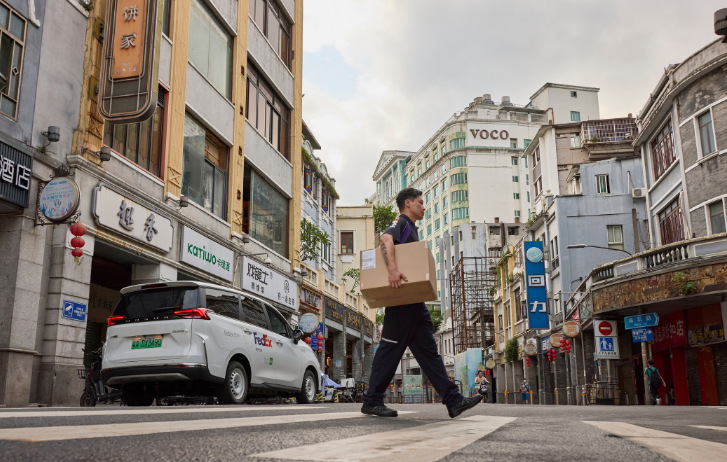
Why Global Brands Should Look East: The Case For Expanding Into APAC
By FedEx | October 16, 2025
Asia Pacific (APAC) is one of the world’s most powerful consumer hubs. With its vast population, thriving e-commerce sector, and supportive trade frameworks, it offers unparalleled opportunities for business expansion. Here are five strategic reasons to enter the APAC market.
- APAC drives nearly 39% of global exports, with consumer spending forecasted to exceed USD 17 trillion in 2025.
- Rising middle-class incomes, rapid urbanization, and digital adoption fuel demand for global products and power APAC’s fast-growing e-commerce market.
- Free trade agreements and investments in logistics infrastructure are gradually lowering barriers to entry, making business expansion to APAC more accessible and viable for global brands.
Imagine your next 100 million customers, ready and waiting in Asia Pacific.
If you haven’t expanded into APAC yet, you could be missing out on one of the world’s most dynamic and opportunity-rich markets. This region is often seen as the world’s factory floor, a powerhouse for exports and manufacturing. But what’s sometimes overlooked is its other identity as the world’s fastest-growing consumer market. It’s a place where spending power is climbing, e-commerce is thriving, and innovation in logistics is reshaping how businesses import goods and connect with customers.
Understandably, the thought of entering this market can feel daunting. Regulations vary widely from country to country. Rich, diverse cultures shape consumer preferences, and it’s not easy to build brand awareness in markets that move at different speeds.
Yet these upfront challenges pale in comparison to the vibrant opportunities waiting here. Here are five strategic reasons why you should consider expanding your brand into the APAC region.
1. APAC accounts for a significant volume of global trade
APAC is the largest consumer market in the world with 4.3 billion people – around 60% of the global population. APAC consumer spending is forecast to reach USD 17.67 trillion by 2025, underscoring the region’s immense purchasing power.
Its influence on global trade is equally striking. In 2024, APAC accounted for nearly 39% of global exports and 37% of global imports, with both figures well above the world average. Retail tells a similar story: APAC generated 37% of global retail sales in 2023, and this share is expected to rise to 40% by 2028.
APAC’s influence on trade and retail is too big to overlook. With its sheer population size, rising consumer spending, and growing share of global exports and imports, the region is fast becoming the world’s economic engine. For globally minded brands, entering APAC will be key to staying relevant in international trade.
2. A growing appetite for global products
From luxury handbags to everyday beauty products, APAC consumers are showing an increasing appetite for imported goods and global brands.
In 2024, sales of personal luxury items – including fashion, leather goods, jewelry, watches, cosmetics, and fragrances – reached nearly USD 199 billion in the region. Five international luxury groups accounted for approximately 40% of the market share in the region, with the remaining share distributed among other global and local luxury brands.
Several forces shape this growing appetite for global products, starting with a rapidly rising middle class. The proportion of middle-class households across APAC increased from 18% in 2013 to 28% in 2023. This means more families have disposable income to spend on discretionary goods, whether it’s designer handbags or everyday skincare.
Rapid urbanization is another key driver of this trend. As more people settle into urban areas, they benefit from increased access to international retail experiences, such as premium shopping malls in city centers, and greater exposure to global products, which drives curiosity and trust in foreign brands.
Finally, always-on connectivity has transformed how consumers discover and buy products. Internet penetration more than doubled in the past decade, making global products accessible at the tap of a screen. This digital shift has lowered barriers for new entrants, creating fertile ground for e-commerce brands looking to import and sell into APAC at scale.
3. A massive pool of tech-savvy online shoppers
Improved connectivity across APAC has created an always-online, mobile-first mindset that’s reshaping the retail landscape. 63% of the region’s consumers now prefer shopping online, with nearly four in ten ranking free delivery as a key factor in their purchase decisions.
The scale of this shift is remarkable: between 2013 and 2023, retail e-commerce sales in APAC grew by an astonishing 630% to reach USD 1.8 trillion. That means the region alone accounted for almost half of the world’s e-commerce sales in 2023, and the momentum is still building.
One of the fastest-growing areas is social commerce, where social platforms double as marketplaces. It’s projected to reach USD 626 billion by 2025. This reflects how deeply digital shopping is woven into everyday life across the region and how consumers are engaging with brands in more interactive and immediate ways.
For companies exploring cross-border e-commerce in APAC, this means access to a massive pool of digitally savvy shoppers ready to embrace global brands. With the right logistics support, businesses can plug directly into this momentum, import efficiently, and connect with customers across markets faster than ever.
4. Low barriers to entry, thanks to trade agreements
Trade rules are often seen as hurdles for new entrants, but in APAC, they’re increasingly becoming an advantage. The region is an active contributor to preferential trade agreements (PTAs), accounting for about half of all such agreements worldwide.
As of 2022, there were 333 agreements at play across APAC, with 202 already in force, 21 signed but not yet implemented, and 110 still under negotiation. More than half of these agreements extend beyond the region, making it easier for global companies to access APAC markets.
These agreements work in practical ways: they reduce tariffs, lower import and operating costs, improve market access, and create greater predictability in cross-border trade. For foreign brands, this means smoother APAC market entry and fewer surprises when expanding into new economies.
Some of the most important agreements shaping trade in the region include the Comprehensive and Progressive Agreement for Trans-Pacific Partnership (CPTPP), which connects 11 economies in the Pacific region and beyond.
The Indo-Pacific Economic Framework for Prosperity (IPEF), on the other hand, links 14 economies, including the US, India, and major ASEAN markets. Lastly, the European Free Trade Association (EFTA) network links participating European markets with 12 APAC economies.
Together, these frameworks provide businesses with a clear path to participate in international trade in APAC.
5. Robust logistics infrastructure across the region
APAC is often described as a “highway of value” for global logistics, and for good reason. The region’s infrastructure is evolving rapidly to keep pace with rising demand, particularly as consumers expect same-day and next-day deliveries as the standard.
Southeast Asia has emerged as a major manufacturing hub, with governments in Indonesia, Malaysia, Thailand, and Vietnam making significant investments in roads, ports, and air freight facilities. These efforts are designed to strengthen supply chains, ease congestion, and reduce import costs for businesses moving goods into APAC markets.
At the same time, several governments are establishing logistics hubs in key cities and provinces to help alleviate demand pressures and optimize supply chains, enabling more cost-efficient delivery for e-commerce businesses expanding into APAC.
We’re also seeing a shift toward proximity. As e-commerce continues to grow, logistics providers are locating facilities closer to end consumers. This ensures goods move faster and more reliably, helping brands meet rising expectations for speed and transparency.
These changes are transforming how businesses expand across borders. Companies today need robust shipping capabilities, smooth customs clearance, and networks that connect seamlessly with major global trade lanes. That’s why FedEx has been strengthening its Asia-US and Asia-Europe flight networks, enabling businesses to link into global markets more predictably and efficiently.
For businesses considering expansion into APAC, this strong logistics backbone is one of the most compelling reasons to move forward. The infrastructure to support importing, fulfillment, and cross-border delivery is already in place, and it’s only getting stronger.
Break into the world’s fastest-growing consumer market
More than just a hub for exports and manufacturing, APAC is becoming the beating heart of global trade. With its vast population and a rising middle class with greater spending power, the region is now the fastest-growing consumer market.
Navigating regulations and adapting to local cultures can feel challenging at first. But trade agreements are steadily lowering barriers to entry, while enhanced logistics infrastructure is making cross-border trade more efficient.
Those contemplating entry into APAC will find the window of opportunity wide open. By moving now, your brand can connect with tech-savvy consumers, tap into robust trade networks, and secure long-term growth in one of the world’s most dynamic markets.
SHARE THIS STORY
- 85% Of APAC Businesses Plan To Expand Into Europe, According To New FedEx Report
- Generative AI: A New Frontier
- How To Ship A Giant Panda
- The Rise Of Intra-Asia Trade: Opportunities In The China-Southeast Asia Corridor
- Where Do Old Planes Go When They Retire?
- What’s So Dangerous About Coconuts? Your Guide To Dangerous Goods Logistics
Sign up now and save on your shipping rates!
Sign up now and earn discounts by shipping instantly with FedEx Ship ManagerTM at fedex.com.
Recommended For You

A Billion-Ton Mega-Industry: The Skyrocketing Value Of China’s Perishable Imports
Learn how China's rising demand for premium fresh produce creates opportunities for global exporters, backed by a robust cold-chain logistics network.
Read More
The Rise Of Asia-Europe Trade – And What It Means For APAC SMEs
Get ready to tap into growing European demand for Asian exports. Explore successful cross-border shipping strategies and how to decode market trends.
Read More
Mastering Customs Clearance In Asia Pacific: Why Agility And Accuracy Are The New Trade Imperatives
Learn how to clear customs seamlessly and understand current regulations with our comprehensive customs compliance guide.
Read More


